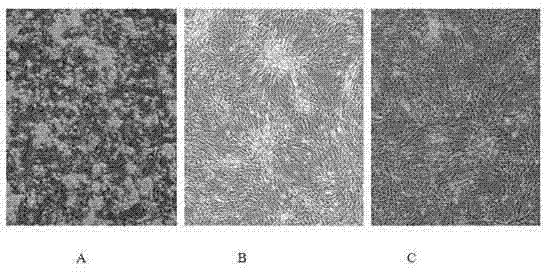Acquisition method of adipose-derived stem cells
A technique for obtaining fat stem cells, which is applied to animal cells, vertebrate cells, bone/connective tissue cells, etc., and can solve the problems of insufficient cell purity and insufficient thorough digestion of cells by type I collagenase
- Summary
- Abstract
- Description
- Claims
- Application Information
AI Technical Summary
Problems solved by technology
Method used
Image
Examples
Embodiment -1
[0034] (1) Take 50mL of adipose tissue, wash with D-Hank's balanced salt solution with a pH value of 7.2-7.4, and repeatedly centrifuge to remove excess aqueous solution and blood;
[0035] Add 0.4% (m / v) collagenase I equal to the volume of the adipose tissue to digest, and digest evenly under the temperature condition of 37oC for 60 minutes, then place it in a centrifuge and centrifuge at a speed of 2000 rpm for 5 minutes. Remove superficial fat. The bottom cells were blown repeatedly with D-Hank's balanced salt solution with a pH value of 7.2-7.4, and cleaned; the cleaned liquid was filtered through a 100-mesh sieve to remove undigested tissue; when the tissue was filtered, it could be seen that there were many incomplete lumps presence of digestive tissue;
[0036] The filtrate was centrifuged at 1000 rpm for 5 minutes, and the supernatant was discarded to obtain SVF cells.
[0037] (2) Add the obtained SVF cells to 10 mL of high-glucose DMEM culture medium containing 10...
Embodiment -2
[0042] (1) Take 50mL of adipose tissue, wash with D-Hank's balanced salt solution with a pH value of 7.2-7.4, and repeatedly centrifuge to remove excess aqueous solution and blood;
[0043] Add 0.3% (m / v) mixed collagenase equal to the volume of the extracted adipose tissue for digestion, shake and digest evenly at 37oC for 60 minutes, then place in a centrifuge and centrifuge at 2000 rpm for 5 minutes. Remove superficial fat. The bottom cells were blown repeatedly with D-Hank's balanced salt solution with a pH value of 7.2-7.4, and cleaned; the cleaned liquid was filtered through a 100-mesh sieve to remove undigested tissue; when the tissue was filtered, it could be seen that there were many incomplete lumps presence of digestive tissue;
[0044] The filtrate was centrifuged at 1000 rpm for 5 minutes, and the supernatant was discarded to obtain SVF cells.
[0045] (2) Add the obtained SVF cells to 10 mL of high-glucose DMEM culture medium containing 10% fetal bovine serum, ...
Embodiment -3
[0050] (1) Take 50mL of adipose tissue, wash with D-Hank's balanced salt solution with a pH value of 7.2-7.4, and repeatedly centrifuge to remove excess aqueous solution and blood;
[0051] Add 0.4% (m / v) mixed collagenase equal to the volume of the adipose tissue obtained for digestion, and digest evenly at a temperature of 37oC for 60 minutes, then place it in a centrifuge and centrifuge at a speed of 2000 rpm for 5 minutes. Remove superficial fat. The bottom cells were blown repeatedly with D-Hank's balanced salt solution with a pH value of 7.2-7.4, and cleaned; the cleaned liquid was filtered through a 100-mesh sieve to remove undigested tissues; incompletely digested tissue blocks were visible during tissue filtration. Significantly decreased in Case-1 and -2;
[0052] The filtrate was centrifuged at 1000 rpm for 5 minutes, and the supernatant was discarded to obtain SVF cells.
[0053] (2) Add the obtained SVF cells to 10 mL of high-glucose DMEM culture medium containi...
PUM
 Login to View More
Login to View More Abstract
Description
Claims
Application Information
 Login to View More
Login to View More - R&D
- Intellectual Property
- Life Sciences
- Materials
- Tech Scout
- Unparalleled Data Quality
- Higher Quality Content
- 60% Fewer Hallucinations
Browse by: Latest US Patents, China's latest patents, Technical Efficacy Thesaurus, Application Domain, Technology Topic, Popular Technical Reports.
© 2025 PatSnap. All rights reserved.Legal|Privacy policy|Modern Slavery Act Transparency Statement|Sitemap|About US| Contact US: help@patsnap.com



